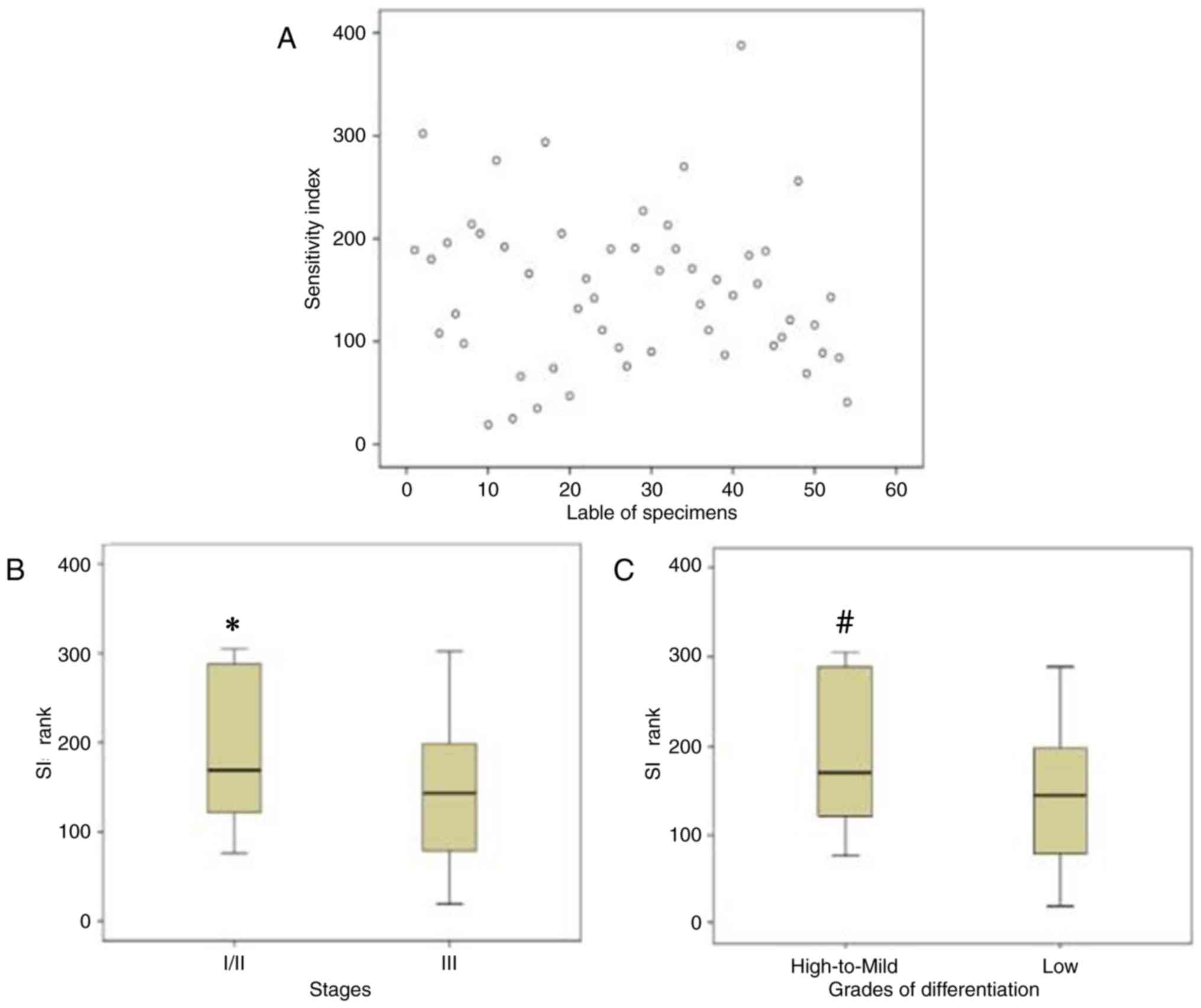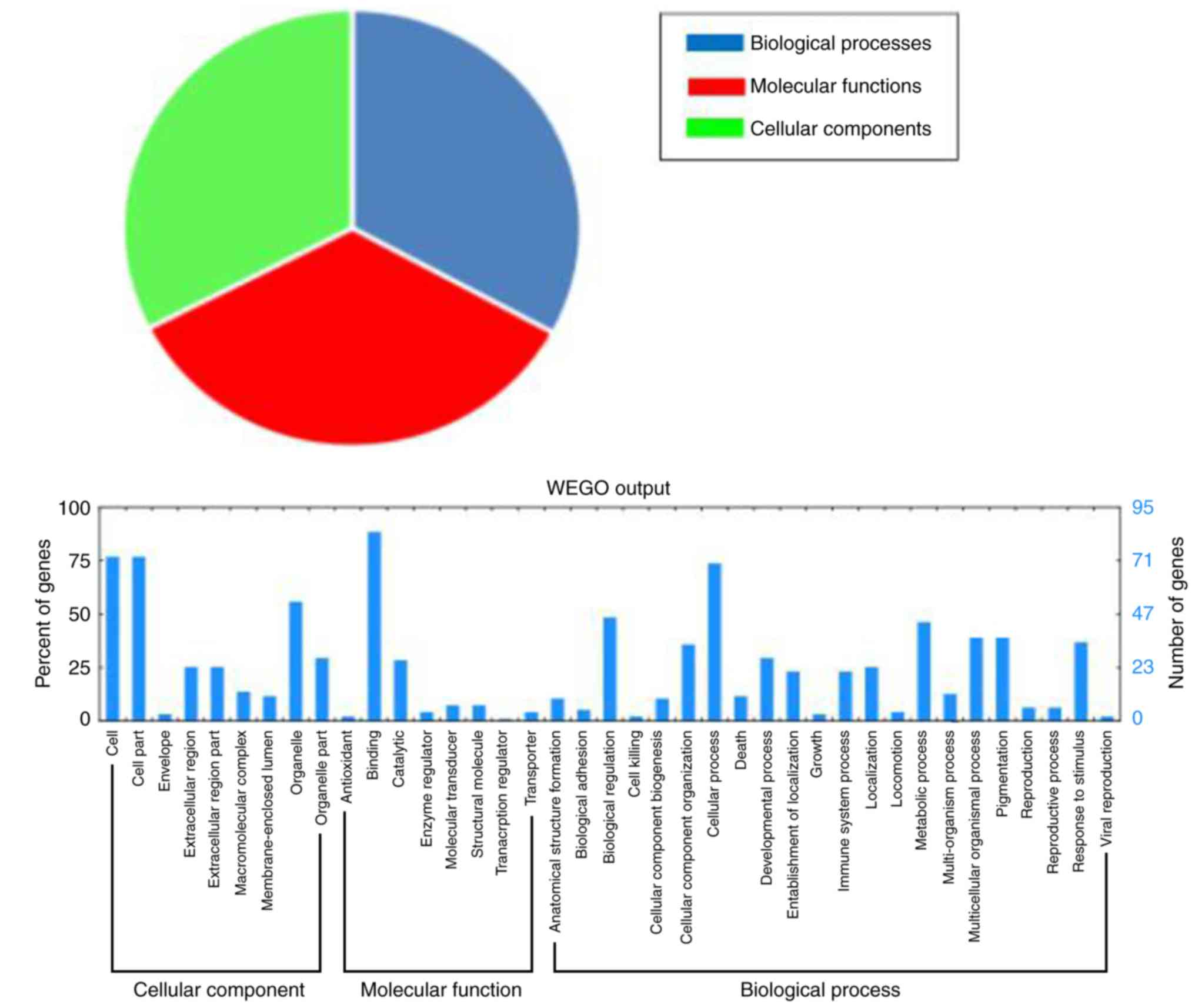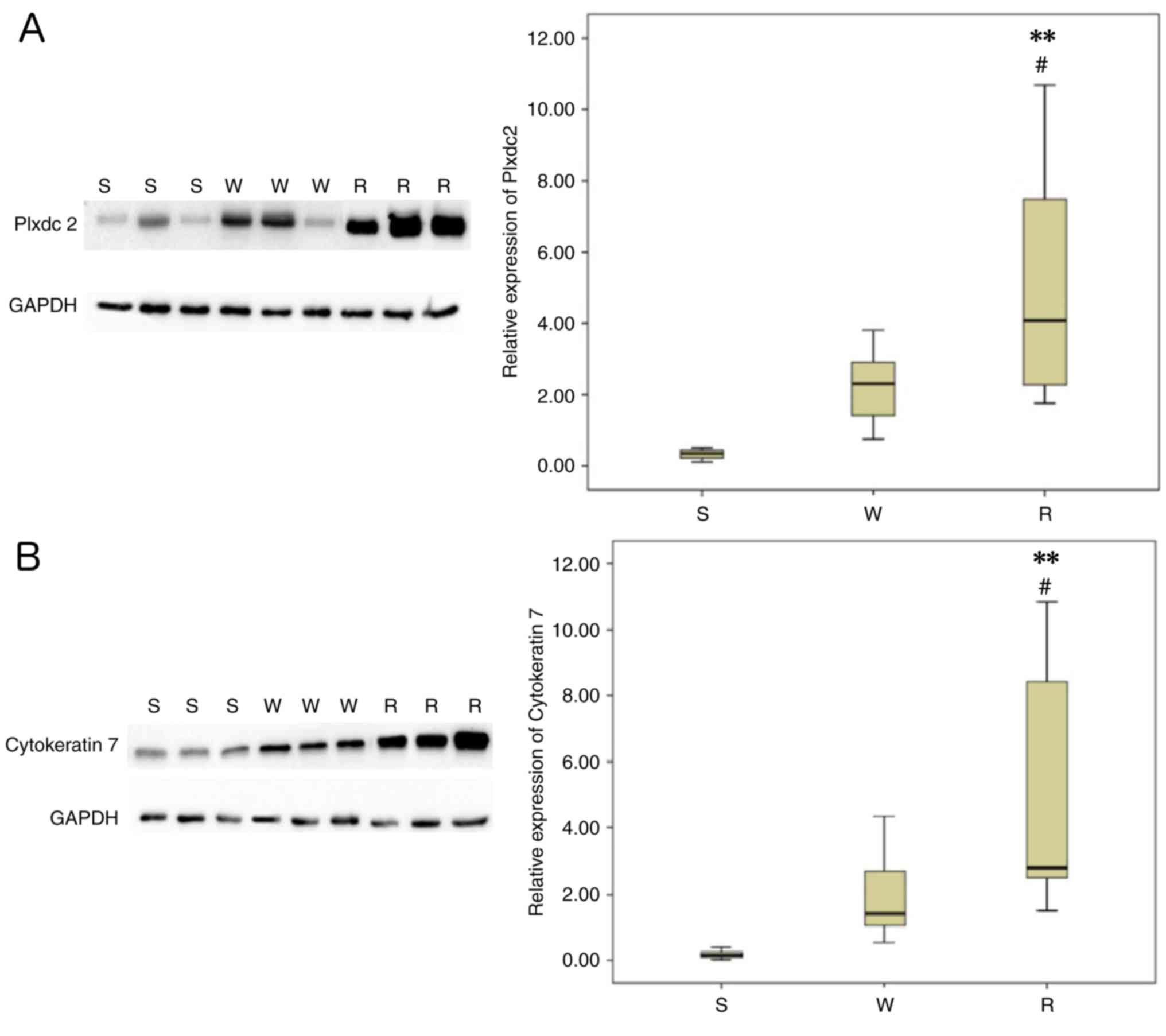|
1
|
Cornelison R, Llaneza DC and Landen CN:
Emerging Therapeutics to overcome chemoresistance in epithelial
ovarian cancer: A mini-review. Int J Mol Sci. 18:E21712017.
View Article : Google Scholar : PubMed/NCBI
|
|
2
|
Duda K, Cholewa H, Łabuzek K,
Boratyn-Nowicka A and Okopień B: Novel strategies of ovarian cancer
treatment. Pol Merku Lekarski. 39:337–342. 2015.
|
|
3
|
Ramalingam P: Morphologic,
immunophenotypic, and molecular features of epithelial ovarian
cancer. Oncology (Williston Park). 30:166–176. 2016.PubMed/NCBI
|
|
4
|
Bookman MA: Optimal primary therapy of
ovarian cancer. Ann Oncol. 27 Suppl 1:i158–i162. 2016. View Article : Google Scholar
|
|
5
|
Matsumoto K, Onda T and Yaegashi N:
Pharmacotherapy for recurrent ovarian cancer: Current status and
future perspectives. Jpn J Clin Oncol. 45:408–410. 2015. View Article : Google Scholar : PubMed/NCBI
|
|
6
|
O'Donnell RL, Kaufmann A, Woodhouse L,
McCormick A, Cross PA, Edmondson RJ and Curtin NJ: Advanced ovarian
cancerdisplays functional intratumor heterogeneity that correlates
to ex vivo drug sensitivity. Int J Gynecol Cancer. 26:1004–1011.
2016. View Article : Google Scholar : PubMed/NCBI
|
|
7
|
Tatar B, Boyraz G, Selçuk İ, Doğan AK,
Usubütün A and Tuncer ZS: In vitro chemosensitivity in ovarian
carcinoma: Comparison of three leading assays. J Turk Ger Gynecol
Assoc. 17:35–40. 2016. View Article : Google Scholar : PubMed/NCBI
|
|
8
|
Zhang H, Zhang L, Wei L, Gao X, Tang LI,
Gong W, Min NA, Zhang LI and Yuan Y: Knockdown of cathepsin L
sensitizes ovarian cancer cells to chemotherapy. Oncol Lett.
11:4235–4239. 2016. View Article : Google Scholar : PubMed/NCBI
|
|
9
|
Lee M, Kim SW, Nam EJ, Cho H, Kim JH, Kim
YT and Kim S: ATP-based chemotherapy response assay in primary or
recurrent ovarian and peritoneal cancer. Yonsei Med J.
55:1664–1671. 2014. View Article : Google Scholar : PubMed/NCBI
|
|
10
|
Han SS, Choi SH, Lee YK, Kim JW, Park NH,
Song YS, Lee HP and Kang SB: Predictive value of individualized
tumor response testing by ATP based chemotherapy response assay in
ovarian cancer. Cancer Invest. 26:426–430. 2008. View Article : Google Scholar : PubMed/NCBI
|
|
11
|
Zhao D, Zhang W, Li XG, Wang XB, Zhang LF,
Li M, Li YF, Tian HM, Song PP, Liu J, et al: Predicting clinical
chemo-sensitivity of primary ovarian cancer using adenosine
triphosphate-tumor chemo-sensitivity assay combined with detection
of drug resistance genes. Zhonghua Fu Chan Ke Za Zhi. 46:193–198.
2011.(In Chinese). PubMed/NCBI
|
|
12
|
Fehm T, Zwirner M, Wallwiener D, Seeger H
and Neubauer H: Antitumor activity of zoledronic acid in primary
breast cancer cells determined by the ATP tumor chemosensitivity
assay. BMC Cancer. 12:3082012. View Article : Google Scholar : PubMed/NCBI
|
|
13
|
Neubauer H, Stefanova M, Solomayer E,
Meisner C, Zwirner M, Wallwiener D and Fehm T: Predicting
resistance to platinum-containing chemotherapy with the ATP tumor
chemosensitivity assay in primary ovarian cancer. Anticancer Res.
28:949–955. 2008.PubMed/NCBI
|
|
14
|
Safinya CR, Chung PJ, Song C, Li Y, Ewert
KK and Choi MC: The effect of multivalent cations and Tau on
paclitaxel-stabilized microtubule assembly, disassembly, and
structure. Adv Colloid Interface Sci. 232:9–16. 2016. View Article : Google Scholar : PubMed/NCBI
|
|
15
|
Tian Y, Tan AC, Sun X, Olson MT, Xie Z,
Jinawath N, Chan DW, Shih IeM, Zhang Z and Zhang H: Quantitative
proteomic analysis of ovarian cancer cells identified mitochondrial
proteins associated with paclitaxel resistance. Proteomics Clin
Appl. 3:1288–1295. 2009. View Article : Google Scholar : PubMed/NCBI
|
|
16
|
Gagné JP, Ethier C, Gagné P, Mercier G,
Bonicalzi ME, Mes-Masson AM, Droit A, Winstall E, Isabelle M and
Poirier GG: Comparative proteome analysis of human epithelial
ovarian cancer. Proteome Sci. 5:162007. View Article : Google Scholar : PubMed/NCBI
|
|
17
|
Tian Y, Yao Z, Roden RB and Zhang H:
Identification of glycoproteins associated with different
histological subtypes of ovarian tumors using quantitative
glycoproteomics. Proteomics. 11:4677–4687. 2011. View Article : Google Scholar : PubMed/NCBI
|
|
18
|
Ling ZQ, Qi CJ, Lu XX, Qian LJ, Gu LH,
Zheng ZG, Zhao Q, Wang S, Fang XH, Yang ZX, et al: Heterogeneity of
chemosensitivity in esophageal cancer using ATP-tumor
chemosensitivity assay. Acta Pharmacol Sin. 33:401–406. 2012.
View Article : Google Scholar : PubMed/NCBI
|
|
19
|
Konecny G, Crohns C, Pelgram M, Felber M,
Lude S, Kurbacher C, Cree IA, Hepp H and Untch M: Correlation of
drug response with the ATP tumorchemosensitivity assay in primary
FIGO stage III ovarian cancer. Gynecol Oncol. 77:258–263. 2000.
View Article : Google Scholar : PubMed/NCBI
|
|
20
|
Wang H, Wu K, Liu Y, Wu Y and Wang X:
Integrative proteomics to understand the transmission mechanism of
Barley yellow dwarf virus-GPV by its insect vector Rhopalosiphum
padi. Sci Rep. 5:109712015. View Article : Google Scholar : PubMed/NCBI
|
|
21
|
Perkins DN, Pappin DJ, Creasy DM and
Cottrell JS: Probability-based protein identification by searching
sequence databases using mass spectrometry data. Electrophoresis.
20:3551–3567. 1999. View Article : Google Scholar : PubMed/NCBI
|
|
22
|
Zhong XW, Zou Y, Liu SP, Yi QY, Hu CM,
Wang C, Xia QY and Zhao P: Proteomic-based insight into Malpighian
tubules of silkworm Bombyx mori. PLoS One. 8:e757312013. View Article : Google Scholar : PubMed/NCBI
|
|
23
|
Shan N, Zhou W, Zhang S and Zhang Y:
Identification of HSPA8 as a candidate biomarker for endometrial
carcinoma by using iTRAQ-based proteomic analysis. Onco Targets
Ther. 9:2169–2179. 2016.PubMed/NCBI
|
|
24
|
Ashburner M, Ball CA, Blake JA, Botstein
D, Butler H, Cherry JM, Davis AP, Dolinski K, Dwight SS, Eppig JT,
et al: Gene ontology: Tool for the unification of biology. Nat
Genet. 25:25–29. 2000. View
Article : Google Scholar : PubMed/NCBI
|
|
25
|
The Gene Ontology Consortium: Expansion of
the Gene Ontology knowledgebase and resources. Nucleic Acids Res.
45:D331–D338. 2017. View Article : Google Scholar : PubMed/NCBI
|
|
26
|
Christie M and Oehler MK: Molecular
pathology of epithelial ovarian cancer. J Br Menopause Soc.
12:57–63. 2006. View Article : Google Scholar : PubMed/NCBI
|
|
27
|
Giordano S, Zucchetti M, Decio A, Cesca M,
Nerini Fuso I, Maiezza M, Ferrari M, Licandro SA, Frapolli R,
Giavazzi R, et al: Heterogeneity of paclitaxel distribution in
different tumor models assessed by MALDI mass spectrometry imaging.
Sci Rep. 6:392842016. View Article : Google Scholar : PubMed/NCBI
|
|
28
|
Symeonides S and Gourley C: Ovarian cancer
molecular stratification and tumor heterogeneity: A necessity and a
challenge. Front Oncol. 5:2292015. View Article : Google Scholar : PubMed/NCBI
|
|
29
|
Zhang J and Li H: Heterogeneity of tumor
chemosensitivity in ovarian epithelial cancer revealed using
theadenosine triphosphate-tumor chemosensitivity assay. Oncol Lett.
9:2374–2380. 2015. View Article : Google Scholar : PubMed/NCBI
|
|
30
|
Miller-Delaney SF, Lieberam I, Murphy P
and Mitchell KJ: Plxdc2 is a mitogen for neural progenitors. PLoS
One. 6:e145652011. View Article : Google Scholar : PubMed/NCBI
|
|
31
|
Miller SF, Summerhurst K, Rünker AE,
Kerjan G, Friedel RH, Chédotal A, Murphy P and Mitchell KJ:
Expression of Plxdc2/TEM7R in the developing nervous system of the
mouse. Gene Expr Patterns. 7:635–644. 2007. View Article : Google Scholar : PubMed/NCBI
|
|
32
|
Qi W, Yang C, Dai Z, Che D, Feng J, Mao Y,
Cheng R, Wang Z, He X, Zhou T, et al: High levels of pigment
epithelium-derived factor in diabetes impair wound healing through
suppression of Wnt signaling. Diabetes. 64:1407–1419. 2015.
View Article : Google Scholar : PubMed/NCBI
|
|
33
|
Cheng G, Zhong M, Kawaguchi R, Kassai M,
Al-Ubaidi M, Deng J, Ter-Stepanian M and Sun H: Identification of
PLXDC1 and PLXDC2 as the transmembrane receptors for the
multifunctional factor PEDF. Elife. 3:e054012014. View Article : Google Scholar : PubMed/NCBI
|
|
34
|
Sagheer U, Gong J and Chung C: Pigment
Epithelium-Derived Factor (PEDF) is a determinant of stem cell
fate: Lessons from an Ultra-Rare disease. J Dev Biol. 3:112–128.
2015. View Article : Google Scholar : PubMed/NCBI
|
|
35
|
Zhang S, Zhai G, Shi W, Wang Y, Zhu L, Dai
Y and Chen C: Pigment Epithelium-Derived factor inhibits
oxygen-induced retinal neovascularization in a murine model. Fetal
Pediatr Pathol. 35:173–185. 2016. View Article : Google Scholar : PubMed/NCBI
|
|
36
|
Belkacemi L and Zhang SX: Anti-tumor
effects of Pigment Epithelium-Derived Factor (PEDF): Implication
for cancer therapy. A mini-review. J Exp Clin Cancer Res. 35:42016.
View Article : Google Scholar : PubMed/NCBI
|
|
37
|
Chuderland D, Ben-Ami I, Bar-Joseph H and
Shalgi R: Role of pigment epithelium-derived factor in the
reproductive system. Reproduction. 148:R53–R61. 2014. View Article : Google Scholar : PubMed/NCBI
|
|
38
|
Sandilands A, Smith FJ, Lunny DP, Campbell
LE, Davidson KM, MacCallum SF, Corden LD, Christie L, Fleming S,
Lane EB and McLean WH: Generation and characterisation of Keratin 7
(K7) knockout mice. PLoS One. e644042013. View Article : Google Scholar : PubMed/NCBI
|
|
39
|
Windoffer R, Beil M, Magin TM and Leube
RE: Cytoskeleton in motion: The dynamics of keratin intermediate
filaments in epithelia. J Cell Biol. 194:669–678. 2011. View Article : Google Scholar : PubMed/NCBI
|
|
40
|
Bayrak R, Yenidunya S and Haltes H:
Cytokeratin 7 and Cytokeratin 20 expression in colorectal
adenocarcinoma. Pathol Res Pract. 207:156–160. 2011. View Article : Google Scholar : PubMed/NCBI
|
|
41
|
Gurzu S and Jung I: Aberrant pattern of
the cytokeratin 7/cytokeratin 20 immunophenotype in colorectal
adenocarcinomas with BRAF mutation. Pathol Res Pract. 208:163–166.
2012. View Article : Google Scholar : PubMed/NCBI
|
|
42
|
Toyoshima M, Momono Y, Makino H, Kudo T,
Oka N, Sakurada J, Suzuki H, Kodama H and Yoshinaga K: Cytokeratin
7-positive/cytokeratin 20-negative cecal adenocarcinoma
metastaticto the uterine cervix: A case report. World J Surg Oncol.
14:222016. View Article : Google Scholar : PubMed/NCBI
|
|
43
|
Chu P, Wu E and Weiss LM: Cytokeratin 7
and cytokeratin 20 expression in epithelial neoplasms: A survey of
435 cases. Mod Pathol. 13:962–972. 2000. View Article : Google Scholar : PubMed/NCBI
|
|
44
|
Shin JH, Bae JH, Lee A, Jung CK, Yim HW,
Park JS and Lee KY: CK7, CK20, CDX2 and MUC2 Immunohisto-chemical
staining used to distinguish metastatic colorectal carcinoma
involving ovary from primary ovarian mucinous adenocarcinoma. Jpn J
Clin Oncol. 40:208–213. 2010. View Article : Google Scholar : PubMed/NCBI
|
|
45
|
Moll R, Divo M and Langbein L: The human
keratins: Biology and pathology. Histochem Cell Biol. 129:705–733.
2008. View Article : Google Scholar : PubMed/NCBI
|

















